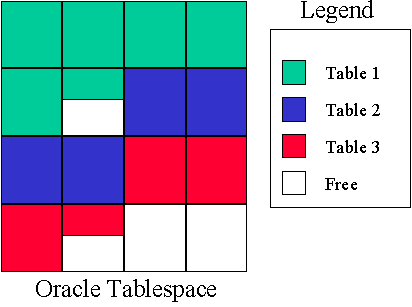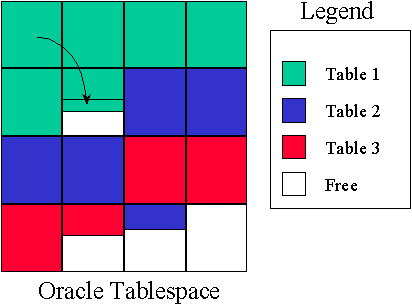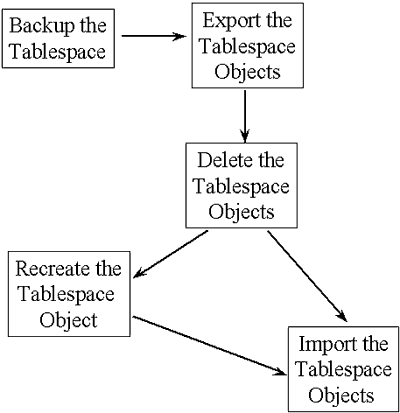 Craig S. Mullins
Craig S. Mullins |
|
| October 1998 |
|
|
|

Dealing with Fragmentation and Disorganization
 Fragmentation and Row Chaining The building block for Oracle storage is the data page. Let's make two data changes to tables in the table space. First, let's add six rows to the second table. But no free space exists into which these new rows can be stored. How can the rows be added? Oracle requires that another extent is taken into which the new rows can be placed. For the second change, let's update a row in the first table to change a VARCHAR2 column; for example, let's change the LASTNAME column from "ROGERS" to "FILIPOWSKI". This update results in an expanded row size because the value for LASTNAME is longer in the new row: "FILIPOWSKI" contains 10 characters whereas "ROGERS" only consists of 6. The resultant table space might now look like this:  Two potential problems are depicted in Figure 2: fragmentation and row chaining. Fragmentation is a condition in which there are many scattered areas of storage in a database that are too small to be used productively. It results in wasted space, which can hinder performance and even cause database failure. When updated data does not fit in the space it currently occupies Oracle will find space for the row using either row chaining or row migration. With row chaining Oracle will move a part of the new, larger row to a location within the table space where free space exists. With row migrations the full row is placed elsewhere in the segment. In each case a block-resident pointer is used to locate either the rest of the row or the full row. Both row chaining and row migration will result in multiple I/Os being issued to read a single row. This will cause performance to suffer because, obviously multiple I/Os are more expensive than a single I/O. Reorganizing Tablespaces To minimize fragmentation and row chaining, database objects must be restructured on a regular basis. This process is also known as reorganization. The primary benefit is the resulting speed and efficiency of database functions because the data is organized in a more optimal fashion on disk. In short, table space reorganization maximizes availability and reliability for Oracle databases Traditionally, DBAs have done this manually by completely rebuilding databases. But a reorganization requires a complex series of steps to accomplish. The diagram in Figure 3 depicts the reorganization process.  In order to accomplish this reorganization, the database must be down. The high cost of downtime creates pressures both to perform and to delay preventive maintenance — a double-bind familiar to all DBAs. Third party tools are available that automate the manual process of defragmentation and reorganization of tables, indexes, and entire tablespaces — eliminating the need for time- and resource-consuming complete database rebuilds. In addition to automation, these type of tools typically speed up the reorg process and analyze whether a reorganization is needed at all. Synopsis Reorganizations can be costly in terms of downtime and computing resources. And it can be difficult to determine when a reorganization will actually create performance gains. However, the performance gains that can be accrued are tremendous when fragmentation and disorganization exist. The wise DBA will plan for Oracle table space reorganization if the above types of disorganization are likely to occur in their systems. From Oracle Update (Xephon), October 1998.
|